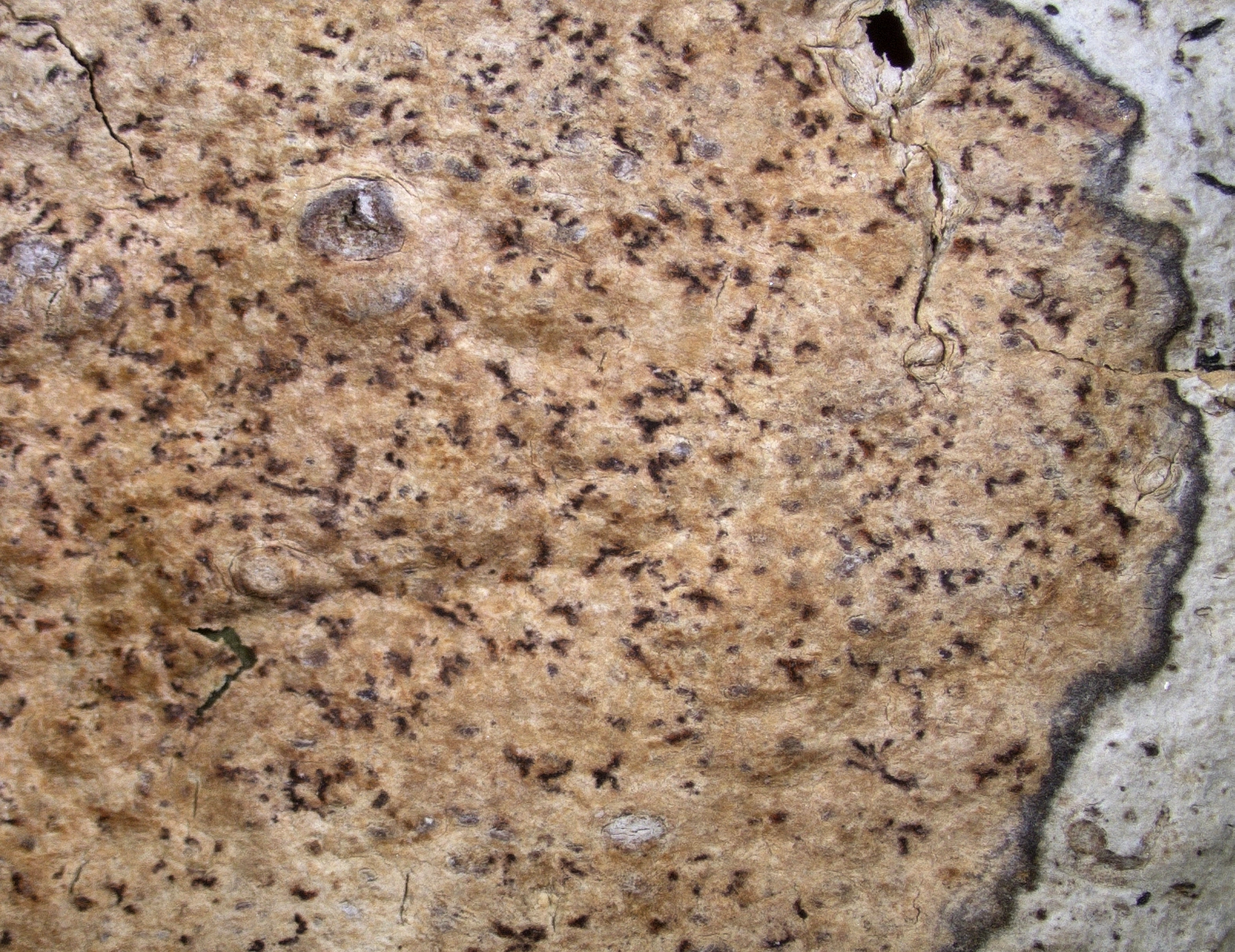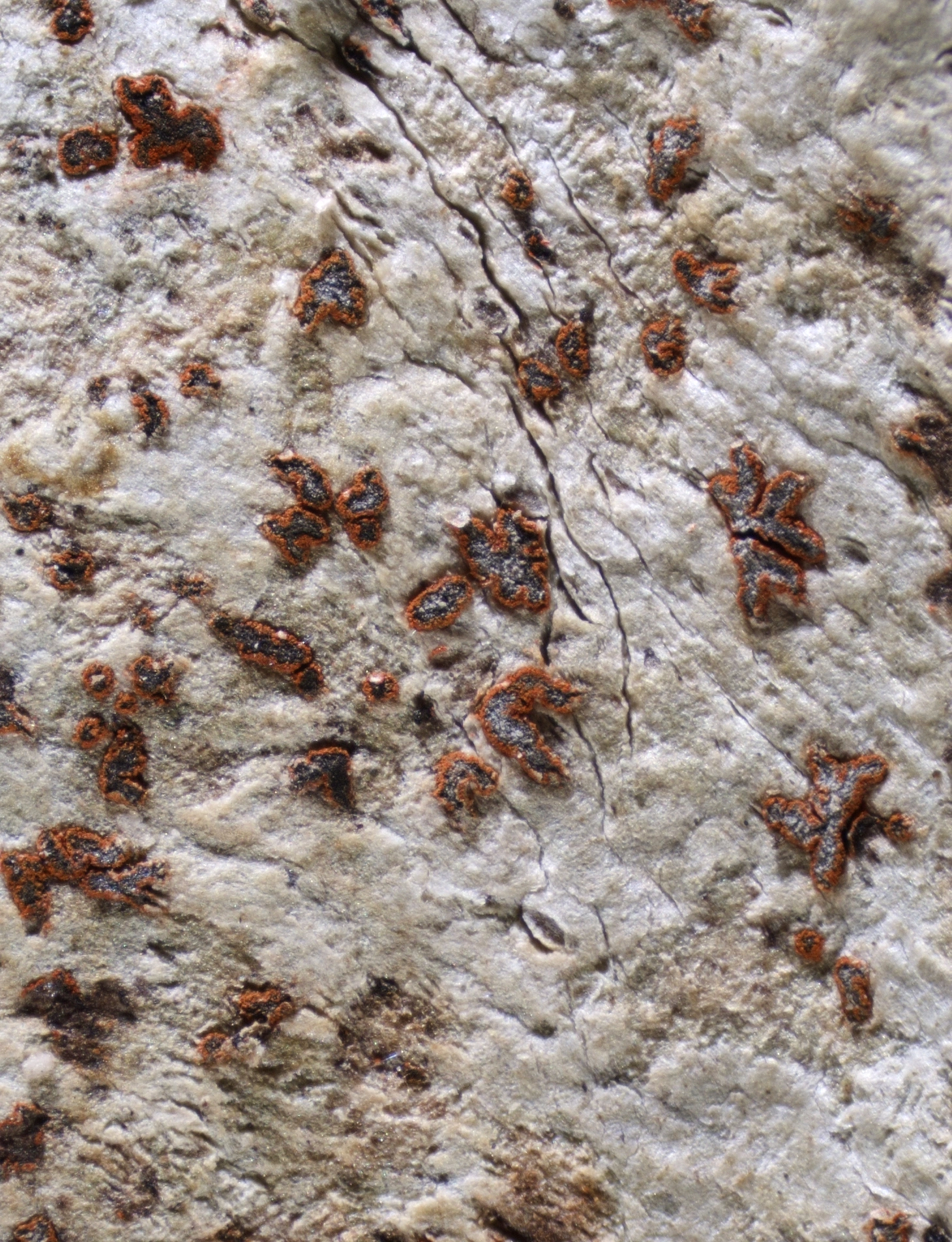Coniocarpon fallax
Coniocarpon fallax collected from Fraxinus excelsior at Nedrevåg-Blåberget in Tysnes (O-L-227304).
Coniocarpon fallax is a species of the boreo-nemoral rainforests and oceanic woodlands from Vest-Agder to Møre og Romsdal. It is characterized by clearly elongated to lirellate apothecia with a distinct orange red pruina. The pale brown spores are (2–)3–4(–5)-transversely septate and have an enlarged apical cell.
- Innhold
- Description
- Ecology
- Distribution in Norway and the Nordic countries
- Global distribution
- Similar species
Description
Thallus
The thallus is pale fawn to grey brown and has a matt to weakly glossy, compact surface. It is immersed in the bark to superficial. The margin is not determinate or delimited by a thin brown line, mainly when in contact with other lichen thalli. The photobiont is a species of the family Trentepohliaceae.
Fruitbodies
The apothecia are raised over the thallus, and are typically elongate or lirellate. They are dark purplish brown in color, and mostly covered in a thick orange red pruina along the apothecial margins and in a thin white pruina on the apothecial disc. Individual lirellae are 0.2–0.4 × 0.1–0.2 mm in size and 65–110 μm tall. They are often aggregated in loose or dense star-shaped clusters reaching 2.5 × 2 mm in size.
The epithecium is 10–20 μm tall, dark brown in color, and includes numerous unpigmented crystals in addition to orange, red and purplish pigmented granules.
The hymenium is 40–75 μm tall and colorless except for an occasional weak and patchily distributed red to purplish pigmentation of the gelatinous matrix.
The hypothecium is colorless or pale brown and 15–30 μm tall.
The paraphysoids are 1–2 μm wide. Their tips are widened to 3–4 μm and extend horizontally above the asci. The tips often protrude from the epithecium to form sparsely branched hair-like extensions up to 15 μm long. The hyphal walls contain patchily distributed brown pigment.
The asci are clavate, with stipe, 50–75 × 20–32 μm in size, and 8-spored.
The spores are colorless, narrow obovate, (15–)17–20 (–22) x (6–) 7–9 (–10) μm in size, and divided by (2–)3–4(–5) transverse septa. The apical cell is enlarged. Old spores are pale brown.
Anamorph
Pycnidia have not been found in the species.
Chemistry
The thallus does not react with C, K, KC, Pd or UV (C–, K–, KC–, Pd–, UV–), but the orange red pruina of the apothecia changes to purple in K (K+ purple). Pigments A1, A2, A3 and A4 in variable amounts have been detected by TLC.
All parts of the apothecia react Idil+ red, I+ red and KI+ blue. A KI+ blue ring structure is present in the tholus of the asci. The orange, red and purple crystals dissolve in K with a clear and fleeting purplish solution.
Coniocarpon fallax collected from Fraxinus excelsior in Vikaneset naturreservat in Sauda (O-L-229858).
Ecology
Coniocarpon fallax is an oceanic species that usually grows on the smooth bark of trees and shrubs in natural to old-growth forests and woodlands including boreo-nemoral rainforests and hazel grooves. From Hidra in Vest-Agder to Vestland county, the species occurs most often on European ash (Fraxinus excelsior) and more rarely on common hazel (Corylus avellana). In Møre og Romsdal, the typical substrate is common hazel (Corylus avellana). Coniocarpon fallax is a rare species that can be locally abundant.
The distribution area of C. cuspidans in Norway ranges from Vest-Agder to Møre og Romsdal, with a large gap in the distribution north of Sognefjorden. The species has been found in various forest communities, including among others oceanic Pinus sylvestris dominated coastal forest, Corylus avellana groves, broad-leaved deciduous forest and Fraxinus excelsior-dominated wooded scree-slopes.
Distribution in Norway and the Nordic countries
Coniocarpon fallax is widespread in oceanic coastal areas of western Norway from Vest-Agder to Møre og Romsdal. In the Nordic countries, it is further known from Gotland in Sweden.
Global distribution
Coniocarpon fallax is widely distributed in oceanic habitats of western and southern Europe. The species has been reported in Austria, the British Islands, France, Italy, Slovenia and Turkey.
Similar species
Coniocarpon fallax is most likely to be confused with C. cinnabarinum. The latter species has distinctly larger spores that measure (19–)23–28(–30) × (8–)10–11(–12) μm in size and have (3–)4–5(–8) transverse septa. The apothecia of C. cinnabarinum are irregularly rounded or lobate, and only rarely clearly elongate. Individuals of C. cinnabarinum with elongate apothecia can only be separated from C. fallax with certainty by the larger spores with more septa.
Poorly developed individuals of C. fallax may lack a well-developed pruina on the apothecia. Such specimens need to be separated with care from C. cuspidans and Arthonia stellaris, which both occur in the same habitat. Coniocarpon fallax never has an orange red pruina and the spores are slightly smaller, (15–)16–18(–20) × (6–)7–8(–9) μm in size and have (2–)3(–4) transverse septa. The apothecia of Arthonia stellaris lack quinoid pigments and are thinner. The spores are 16–22 × 6–7 μm in size and have (2–) 3–4 transverse septa.
Some further Arthoniaceae in Norway contain reddish, K+ purple pigments in the apothecia. The spores in all of them are only 1-septate and the reddish pigment is diffusely distributed in the gelatinous matrix only and not crystalline as in the Coniocarpon species.
Literature
Cannon P, Ertz D, Frisch A, Aptroot A, Chambers S, Coppins BJ, Sanderson N, Simkin J and Wolseley P (2020). Arthoniales: Arthoniaceae. Revisions of British and Irish Lichens 1: 1–48.
Frisch A, Moen VS, Grube M and Bendiksby M (2020). Integrative taxonomy confirms three species of Coniocarpon (Arthoniaceae) in Norway. MycoKeys 62: 27–51.




